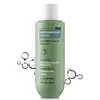What's inside
What's inside
 Key Ingredients
Key Ingredients

 Benefits
Benefits

 Concerns
Concerns

 Ingredients Side-by-side
Ingredients Side-by-side

Water
Skin ConditioningSodium Lauroyl Methyl Isethionate
CleansingCocamidopropyl Betaine
CleansingPropanediol
SolventDimethiconol
EmollientGlycerin
HumectantTea-Dodecylbenzenesulfonate
CleansingAcrylates Copolymer
Parfum
MaskingPiroctone Olamine
PreservativeSalicylic Acid
MaskingEpilobium Angustifolium Extract
Skin ConditioningPanthenol
Skin ConditioningRosmarinus Officinalis Leaf Extract
AntimicrobialNasturtium Officinale Extract
PerfumingSalvia Officinalis Leaf Extract
CleansingNiacin
SmoothingBiotin
AntiseborrhoeicAloe Barbadensis Leaf Extract
EmollientMenthol
MaskingMilk Protein
Skin ConditioningStearamidopropyl Dimethylamine
EmulsifyingGlycol Stearate
EmollientGuar Hydroxypropyltrimonium Chloride
Skin ConditioningMica
Cosmetic ColorantTitanium Dioxide
Cosmetic ColorantTin Oxide
AbrasivePEG-45m
HumectantSodium Chloride
MaskingCitric Acid
BufferingPhenoxyethanol
PreservativeSodium Benzoate
MaskingDisodium EDTA
Water, Sodium Lauroyl Methyl Isethionate, Cocamidopropyl Betaine, Propanediol, Dimethiconol, Glycerin, Tea-Dodecylbenzenesulfonate, Acrylates Copolymer, Parfum, Piroctone Olamine, Salicylic Acid, Epilobium Angustifolium Extract, Panthenol, Rosmarinus Officinalis Leaf Extract, Nasturtium Officinale Extract, Salvia Officinalis Leaf Extract, Niacin, Biotin, Aloe Barbadensis Leaf Extract, Menthol, Milk Protein, Stearamidopropyl Dimethylamine, Glycol Stearate, Guar Hydroxypropyltrimonium Chloride, Mica, Titanium Dioxide, Tin Oxide, PEG-45m, Sodium Chloride, Citric Acid, Phenoxyethanol, Sodium Benzoate, Disodium EDTA
Water
Skin ConditioningButylene Glycol
HumectantAlcohol Denat.
AntimicrobialCetyl Ethylhexanoate
EmollientHomosalate
Skin ConditioningDibutyl Adipate
EmollientBis-Ethylhexyloxyphenol Methoxyphenyl Triazine
Skin ConditioningCyclopentasiloxane
EmollientMethylene Bis-Benzotriazolyl Tetramethylbutylphenol
UV FilterPolysilicone-15
UV FilterDiethylamino Hydroxybenzoyl Hexyl Benzoate
UV FilterThymus Extract
Skin ConditioningRosmarinus Officinalis Leaf Extract
AntimicrobialHouttuynia Cordata Extract
Skin ConditioningSea Water Extract
Skin ConditioningCeteareth-10
EmulsifyingTromethamine
BufferingDecyl Glucoside
CleansingAcrylates/C10-30 Alkyl Acrylate Crosspolymer
Emulsion StabilisingCarbomer
Emulsion StabilisingCetyl PEG/PPG-10/1 Dimethicone
EmulsifyingPropanediol
SolventPropylene Glycol
Humectant1,2-Hexanediol
Skin ConditioningXanthan Gum
EmulsifyingHyaluronic Acid
HumectantDipropylene Glycol
HumectantMadecassoside
AntioxidantMethyl Diisopropyl Propionamide
MaskingCeramide NP
Skin ConditioningStearyl Heptanoate
EmollientStearyl Caprylate
EmollientParfum
MaskingPhenoxyethanol
PreservativeHydroxycitronellal
PerfumingLinalool
PerfumingCitronellol
PerfumingLimonene
PerfumingAlpha-Isomethyl Ionone
PerfumingWater, Butylene Glycol, Alcohol Denat., Cetyl Ethylhexanoate, Homosalate, Dibutyl Adipate, Bis-Ethylhexyloxyphenol Methoxyphenyl Triazine, Cyclopentasiloxane, Methylene Bis-Benzotriazolyl Tetramethylbutylphenol, Polysilicone-15, Diethylamino Hydroxybenzoyl Hexyl Benzoate, Thymus Extract, Rosmarinus Officinalis Leaf Extract, Houttuynia Cordata Extract, Sea Water Extract, Ceteareth-10, Tromethamine, Decyl Glucoside, Acrylates/C10-30 Alkyl Acrylate Crosspolymer, Carbomer, Cetyl PEG/PPG-10/1 Dimethicone, Propanediol, Propylene Glycol, 1,2-Hexanediol, Xanthan Gum, Hyaluronic Acid, Dipropylene Glycol, Madecassoside, Methyl Diisopropyl Propionamide, Ceramide NP, Stearyl Heptanoate, Stearyl Caprylate, Parfum, Phenoxyethanol, Hydroxycitronellal, Linalool, Citronellol, Limonene, Alpha-Isomethyl Ionone
Ingredients Explained
These ingredients are found in both products.
Ingredients higher up in an ingredient list are typically present in a larger amount.
Parfum is a catch-all term for an ingredient or more that is used to give a scent to products.
Also called "fragrance", this ingredient can be a blend of hundreds of chemicals or plant oils. This means every product with "fragrance" or "parfum" in the ingredients list is a different mixture.
For instance, Habanolide is a proprietary trade name for a specific aroma chemical. When used as a fragrance ingredient in cosmetics, most aroma chemicals fall under the broad labeling category of “FRAGRANCE” or “PARFUM” according to EU and US regulations.
The term 'parfum' or 'fragrance' is not regulated in many countries. In many cases, it is up to the brand to define this term.
For instance, many brands choose to label themselves as "fragrance-free" because they are not using synthetic fragrances. However, their products may still contain ingredients such as essential oils that are considered a fragrance by INCI standards.
One example is Calendula flower extract. Calendula is an essential oil that still imparts a scent or 'fragrance'.
Depending on the blend, the ingredients in the mixture can cause allergies and sensitivities on the skin. Some ingredients that are known EU allergens include linalool and citronellol.
Parfum can also be used to mask or cover an unpleasant scent.
The bottom line is: not all fragrances/parfum/ingredients are created equally. If you are worried about fragrances, we recommend taking a closer look at an ingredient. And of course, we always recommend speaking with a professional.
Learn more about ParfumPhenoxyethanol is a preservative that has germicide, antimicrobial, and aromatic properties. Studies show that phenoxyethanol can prevent microbial growth. By itself, it has a scent that is similar to that of a rose.
It's often used in formulations along with Caprylyl Glycol to preserve the shelf life of products.
Propanediol is an all-star ingredient. It softens, hydrates, and smooths the skin.
It’s often used to:
Propanediol is not likely to cause sensitivity and considered safe to use. It is derived from corn or petroleum with a clear color and no scent.
Learn more about PropanediolRosmarinus Officinalis Leaf Extract comes from rosemary. Rosemary is native to the Mediterranean.
While Rosmarinus Officinalis Leaf Oil can be volatile due to its fragrant properties, the fragrance components are usually removed in the leaf extract.
Rosemary Leaf Extract contains many antioxidants such as rosmarinic acid and caffeic acid. Rosemarinic acid, a compound found in rosemary leaf, has been found to help soothe skin conditions such as eczema and acne.
Learn more about Rosmarinus Officinalis Leaf ExtractWater. It's the most common cosmetic ingredient of all. You'll usually see it at the top of ingredient lists, meaning that it makes up the largest part of the product.
So why is it so popular? Water most often acts as a solvent - this means that it helps dissolve other ingredients into the formulation.
You'll also recognize water as that liquid we all need to stay alive. If you see this, drink a glass of water. Stay hydrated!
Learn more about Water